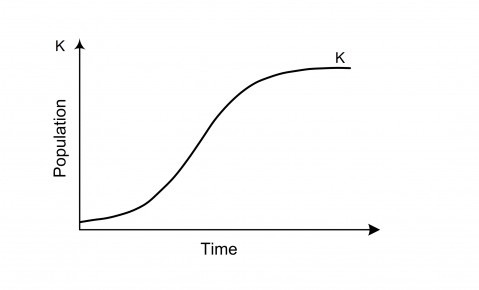This is a term used in the field of ecology to indicate the maximum population of a particular species that a given area of habitat can support over a given period without destroying or hampering the resource base.
The population of any species (including humans) in a territory may increase in different patterns. It may increase exponentially, i.e. in geometric progression from 1, 2, 4, 8, 16, etc., sometimes referred to as Malthus’ law of population growth. Or, more realistically, it may increase according to Verhulst’s law (1838), representing a logistic curve. Population is represented in the vertical axis and time in the horizontal axis whereby maximum population ‘k’ is determined by the carrying capacity of a territory (Figure 1).
Factors that affect the impacts/pressures of different animal species on a given tract of land and its resources include: disease/parasites; starvation; predators; pollution; accidents; old age; hunting and development by humans that results in loss of habitat. Applied to the human species, we can say of a given territory (the Netherlands, for instance) that with its population density of 400 people per km2, it has exceeded its carrying capacity, because there is no way in which this country could sustainably support its population at its current standard of living, directly from the resources in its own territory.
Carrying capacity can be affected by factors such as technological advances, trade and exosomatic use of energy (fossil fuels). Changes in technology modify the carrying capacity of a territory as irrigation and fertilisation in agriculture, for example, or shorter rotations between crops, which increases the number of people who can be fed from the resources of a given territory. Trade among territories increases an area’s carrying capacity as elements in short supply locally are imported. In contrast, as availability of fossil fuels decreases with peak oil, the carrying capacity of many territories for humans will decrease.
For further reading:
Daily, G.C., and Ehrlich, P. R. (1992). Population, sustainability, and Earth’s carrying capacity. BioScience, 42(10), 761-771.
Rees, W.E., and Wackernagel, M. (1996). Ecological footprints and appropriated carrying capacity: Measuring the natural capital requirements of the human economy. Focus, 6(1), 45-60.
This glossary entry is based on a contribution by Julien Francois Gerber
EJOLT glossary editors: Hali Healy, Sylvia Lorek and Beatriz Rodríguez-Labajos




